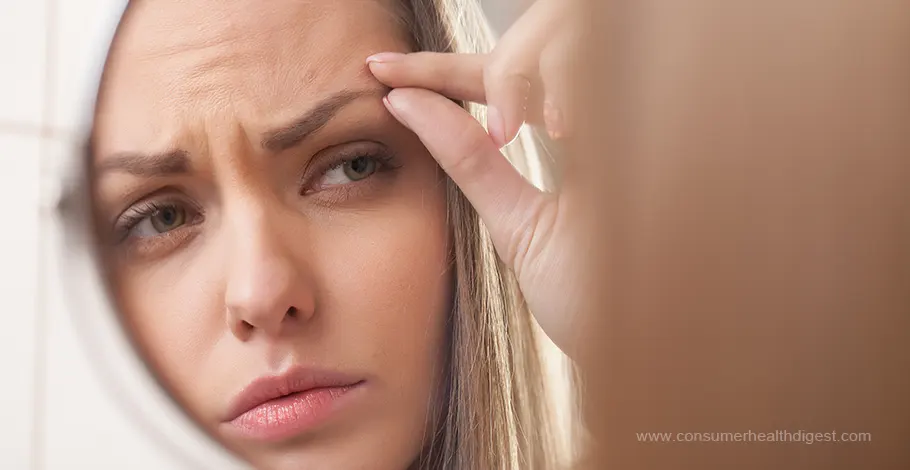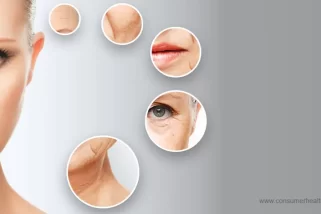Forehead wrinkles, frequently referred to as worry lines or expression lines, are a common dermatological concern for many. These lines, whether horizontal across the forehead or vertical between the eyebrows (often dubbed as “elevens”), are often seen as unwanted signs of aging.

The formation of these wrinkles is intricately linked to several factors, including the aging process itself, which results in the loss of collagen and elastin—key proteins responsible for keeping our skin firm and elastic.
Additionally, the myriad of facial expressions we perform daily, from squinting in bright light to raising our eyebrows in surprise, contributes to the deepening of these lines over time. The sun’s harmful UV rays further exacerbate the situation by breaking down collagen and speeding up the aging process.
Why Do We Get Forehead Wrinkles?
Forehead wrinkles emerge as a common skin concern, drawing attention to the natural and external factors that contribute to their development. It's crucial to understand that while aging gracefully is a beautiful process, there are certain steps we can take to manage the signs that come with it, particularly when it comes to our skin. [1]
- Natural Aging: Our skin undergoes significant changes as we age. One of the most notable changes is the decrease in collagen and elastin production. These proteins are the building blocks of our skin, providing it with structure and the ability to snap back after movement. As their levels drop, the skin becomes thinner and less resilient, making it more prone to wrinkles. Regular moisturizing and the use of products designed to boost collagen production can support skin health during this process.
- Repetitive Expressions: The simple act of expressing emotions through facial movements can contribute to forehead wrinkles. Whether it's squinting against the sunlight or raising your eyebrows in surprise, these repetitive motions strain the frontalis muscle on the forehead. Over time, this can lead to the development of deep-set lines as the skin loses its ability to smooth out these expressions. To counteract this, being conscious of excessive frowning or squinting and incorporating facial relaxation techniques into your routine can be beneficial. [2]
- Sun Damage: Perhaps the most preventable cause of forehead wrinkles is damage caused by exposure to the sun's ultraviolet rays. These rays not only harm the skin's surface but also penetrate deeply, breaking down collagen and elastin faster than they would naturally degrade. This premature aging makes the skin more susceptible to wrinkles. The solution is simple yet effective—regular application of a broad-spectrum SPF sunscreen can protect the skin, preserving its youthfulness and preventing further damage. [3]
The key takeaway is that while forehead wrinkles are a natural part of the aging process, our everyday actions have a profound impact on their severity and onset. By adopting a proactive skincare routine that addresses these three critical factors, we arm ourselves with the tools necessary to maintain smooth, radiant skin for years to come. This not only enhances our appearance but also boosts our confidence, allowing our inner beauty to shine through at any age.
How to Prevent Forehead Wrinkles?

Prevent Forehead Wrinkles. Shutterstock Image
Preventing forehead wrinkles might seem like a daunting task, but with the right approach, it's entirely feasible. By implementing a few key strategies into your daily routine, you can significantly reduce the development of these lines and maintain a youthful complexion. Here are the essential steps you should consider:
Consistent Skin Care Regimen:
- Use Sunscreen Daily: Applying a broad-spectrum sunscreen with an SPF of 30 or higher every day, regardless of the weather, protects your skin from harmful UV rays that accelerate aging. [4]
- Moisturize Regularly: Keeping your skin moisturized is vital for its health. Choose products that suit your skin type and consider those containing hyaluronic acid for enhanced hydration. [5]
- Incorporate Retinoids [6] and Hyaluronic Acid: [7] These ingredients are known for boosting collagen production and improving skin texture, making them excellent additions to your nighttime regimen.
Facial Expression Management:

Facial Expression Wrinkles. Shutterstock Image
Being constantly aware of expressions like frowning or squinting can help in reducing repetitive motion lines. Practicing facial relaxation and massage techniques can also ease muscle tension in the forehead, contributing to a smoother appearance.
Adopt a Healthy Lifestyle:
- Manage Stress: Activities such as meditation, yoga, or any form of exercise that you enjoy can significantly lower stress levels, which in turn, reduces the likelihood of stress-related wrinkles.
- Stay Hydrated: Drinking plenty of water throughout the day is essential for maintaining skin elasticity and keeping it plump, which naturally diminishes the appearance of fine lines.
- Quit Smoking: Smoking not only affects your lungs but also harms collagen, a protein crucial for maintaining skin elasticity. Collagen breakdown leads to accelerated wrinkle formation. Moreover, smoking exposes your skin to harmful air pollutants, further contributing to premature aging signs on your face.
- Eat a Balanced Diet: Your dietary choices play a significant role in skin aging. For instance, Vitamin C is essential for collagen synthesis, while Omega-3 fatty acids help in collagen maintenance. Antioxidants found in fruits and vegetables combat free radicals, protecting your skin from oxidative stress. Incorporating healthy fats, a variety of fruits, and colorful vegetables into your meals can promote skin health and overall well-being.
By integrating these straightforward but powerful strategies into your everyday life, you can effectively prevent or minimize forehead wrinkles. Remember, the goal is not just to look better on the outside but to also nurture your skin's health from within.
Treatment Options for Forehead Wrinkles

Injectable Treatments. Shutterstock Image
For those seeking more immediate or dramatic results in combating forehead wrinkles, several treatment options are available that focus on reducing their appearance significantly. It's essential to understand each treatment's nature to make an informed choice.
-
Injectable Treatments (Botox):
-
Hyaluronic Acid Fillers:
Botox has become a popular solution for addressing forehead wrinkles. It works by temporarily relaxing the muscles beneath the skin, smoothing out wrinkles and preventing the formation of new ones. Results typically last for 3 to 6 months. Remember, choosing an experienced and licensed provider is crucial for the best outcome.
Hyaluronic Acid Fillers are designed to plump up the skin and reduce the appearance of deep lines by adding volume to the forehead region. The effects can be seen almost immediately and can last from 6 to 12 months, depending on the type of filler used and your body's reaction to it [8]
Below are some tips for considering cosmetic treatments:
- Do Your Research: Understand the qualifications of the provider. Look for reviews and before-after photos.
- Consultation Is Key: Have a detailed discussion with your provider about your expectations, potential risks, and the aftercare required.
- Post-Treatment Care: Follow any post-treatment instructions carefully to ensure the best results and minimize any side effects.
By considering these advanced cosmetic procedures, individuals can choose the most suitable option to achieve a smoother, more youthful appearance. However, it's always important to balance expectations and opt for treatments that not only enhance appearance but also maintain the overall health of your skin.
Conclusion
Combating forehead wrinkles involves a multifaceted approach that combines preventative measures, skincare routines, and potentially advanced cosmetic treatments. By understanding the underlying causes such as natural aging, repetitive expressions, and sun damage, individuals can take proactive steps to mitigate their impact.
A consistent skincare regimen that includes the use of sunscreen, moisturizers, retinoids, and hyaluronic acid, along with managing facial expressions and adopting a healthy lifestyle, serves as the foundation for maintaining youthful skin. For those seeking more immediate or significant results, options like Botox and hyaluronic acid fillers offer effective solutions.
However, the importance of conducting thorough research, consulting with experienced professionals, and following post-treatment care cannot be overstated. Ultimately, the goal is not only to enhance one's appearance but to foster skin health, ensuring a smooth, radiant complexion that reflects one's inner beauty and confidence.
8 Sources
We review published medical research in respected scientific journals to arrive at our conclusions about a product or health topic. This ensures the highest standard of scientific accuracy.
[2] Dong Z, Wang G, Lu S, Li J, Yan W, Wang SJ. Spontaneous Facial Expressions and Micro-expressions Coding: From Brain to Face. Front Psychol. 2022 Jan 4;12:784834. doi: 10.3389/fpsyg.2021.784834. PMID: 35058850; PMCID: PMC8763852.
[3] Schwartz E, Cruickshank FA, Christensen CC, Perlish JS, Lebwohl M. Collagen alterations in chronically sun-damaged human skin. Photochem Photobiol. 1993 Dec;58(6):841-4. doi: 10.1111/j.1751-1097.1993.tb04981.x. PMID: 8310007.
[4] "Sunscreen." Skin Cancer Foundation, 30 Nov. 2023, www.skincancer.org/skin-cancer-prevention/sun-protection/sunscreen/#:~:text=Studies%20show%20that%20regular%20daily,wrinkles%2C%20sagging%20and%20age%20spots.
[5] Purnamawati S, Indrastuti N, Danarti R, Saefudin T. The Role of Moisturizers in Addressing Various Kinds of Dermatitis: A Review. Clin Med Res. 2017 Dec;15(3-4):75-87. doi: 10.3121/cmr.2017.1363. Epub 2017 Dec 11. PMID: 29229630; PMCID: PMC5849435.
[6] Zasada M, Budzisz E. Retinoids: active molecules influencing skin structure formation in cosmetic and dermatological treatments. Postepy Dermatol Alergol. 2019 Aug;36(4):392-397. doi: 10.5114/ada.2019.87443. Epub 2019 Aug 30. PMID: 31616211; PMCID: PMC6791161.
[7] Juncan AM, Mois? DG, Santini A, Morgovan C, Rus LL, Vonica-?incu AL, Loghin F. Advantages of Hyaluronic Acid and Its Combination with Other Bioactive Ingredients in Cosmeceuticals. Molecules. 2021 Jul 22;26(15):4429. doi: 10.3390/molecules26154429. PMID: 34361586; PMCID: PMC8347214.
[8] Brandt FS, Cazzaniga A. Hyaluronic acid gel fillers in the management of facial aging. Clin Interv Aging. 2008;3(1):153-9. doi: 10.2147/cia.s2135. PMID: 18488885; PMCID: PMC2544360.







 This article changed my life!
This article changed my life! This article was informative.
This article was informative. I have a medical question.
I have a medical question.
 This article contains incorrect information.
This article contains incorrect information. This article doesn’t have the information I’m looking for.
This article doesn’t have the information I’m looking for.